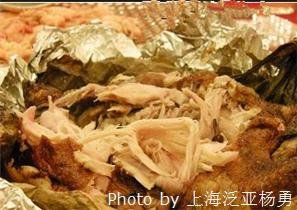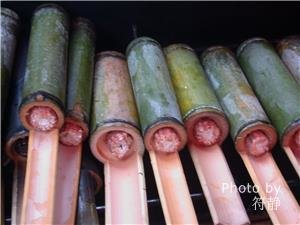Traditional Asian cuisine or to be specific Japanese cuisine, washoku, usually consisting of rice, soup and vegetables and featuring a variety of mostly mild and delicate flavors, has become well known throughout the world. Recently, washoku – a way of cooking, presenting and eating traditional Japanese cuisine – was inducted into UNESCO‘s Cultural Heritage list.
1. Bread and Japanese bakeries
In Japan, as is the case with most Asian countries, rice is the staple grain. Rice has played an important role in socio-economic history of the Japan, and, up until the modern era, was even used for taxation purposes instead of a manufactured currency. Following the Meiji Restoration, the Japanese diet became increasingly westernized. Bread grew in popularity, and now occupies an important and flourishing role in Japan’s food culture. A visit to any of Japan’s numerous bakeries will reveal a great variety of well-crafted products: everything from delicious sweets and French-style baguettes to shrimp rolls and pigs-in-a-blanket.using rice as a base in recipes. In addition to regular bread, some bakeries make rice bread, a special type of bread using rice flour, in hopes of increasing consumption of domestically grown rice.
2. Ice cream, with a Japanese twist
Ice cream probably isn’t the first thing to come to mind when someone mentions Japanese food. Yet, Japan is home to some truly unique flavors of this summertime favourite — the kinds of things you won’t find on US ice cream maker Baskin Robbins‘ famous list of 31 flavors. Among the more popular Japanese flavors are maccha (green tea), sakura (cherry blossom), satsumaimo (sweet potato), goma (black sesame seed) and yuzu (a type of citrus fruit with a flavor similar to mandarin orange mixed with lemon).
Less common are exotic flavors [ja] that you wouldn't find anywhere else but in Japan, based on local specialties. These include basashi (horse-meat sashimi), eel, and wasabi (Japanese horseradish). Such varieties can be found in particular souvenir shops in locations where the ingredients are local specialities.
3. Gekikara ramen and other spicy foods
Japanese food has a reputation for being mild, and some might even go so far as to call it bland. However, anyone willing to make that generalization has obviously never experienced a bowl of gekikara ramen, a version of the ubiquitous noodle dish flavored with potent spices. Those brave enough to try a bowl should expect to sweat a bit! And while Japanese curry is typically sweeter and less fiery than its Indian counterpart, some curry shops will allow you to select your level of spiciness, the higher of which will definitely pack some heat.
4. Raw egg
One of the hallmarks of Japanese food is the abundance of fresh ingredients that are quite often used raw. The best known example of this is the raw seafood used in sushi, but several other raw foods figure prominently in Japanese cooking.
Raw egg, for example, can be found in many dishes, typically served on top of rice, or as a dip for noodles. This presents, arguably, one of the greatest difficulties Americans face when sampling the array of Japanese food. American children are taught from a very early age to regard eggs with extreme caution. In the interest of preventing food-borne illnesses, Americans learn to always wash their hands after handling raw egg, to be careful not to cross-contaminate other foods with raw egg, to always store eggs in the refrigerator, and certainly never to eat eggs raw. This can be quite a shock for American visitors to Japan, who will find eggs stored on grocery shelves at room temperature, and eggs served entirely uncooked in a number of restaurant dishes.
That said, if properly handled, raw egg – sourced from clean, healthy chickens – is perfectly safe for human consumption. And everyone should try the humorously named oyakodon (mother and child bowl), which consists of cooked chicken and reduced onion served over rice with raw egg on top, at least once.
5. Okonomiyaki and common cuisine
Japan is a destination for foodies and gastronomes the world over, seeking the subtle and sublime qualities of Japan’s high-end dishes. This has led to a somewhat skewed perception of Japanese cuisine, as common Japanese dishes – the cheap and delicious meals enjoyed daily by average people – are sorely underrepresented abroad.
A great example of this is okonomiyaki. Many varieties and regional variations ofokonomiyaki exist; in fact, the name itself means “cooked how you like it.” The basic formula, however, includes different vegetables (often: cabbage, carrot and/or onion) and meats (often: squid, pork, shrimp and/or beef), diced and mixed into a pancake-like batter, cooked on a flat-top grill and garnished according to personal preference (often with a type of barbecue sauce, mayonnaise, edible seaweed and/or dried bonito flakes).
Bars and restaurants that serve okonomiyaki usually have a great social atmosphere, given that okonomiyaki can be cut into pieces with a metal spatula and shared with friends or family. Actually, many places allow groups of patrons to make their own okonomiyaki by ordering ingredients and using a griddle built right into the tables. This do-it-yourself style is not uncommon to other forms of Japanese common cuisine, including the ever-popular takoyaki (octopus balls).
6. Whiskey!
It might be considered cheating to include a section on whiskey, quite clearly a beverage, in an article intended to be about Japanese food. But would any article about French cuisine fail to include mention of French wine? Food and alcohol have a long relationship, though Japan’s affection for good whiskey is somewhat surprising, considering that sake usually hogs the cultural spotlight. Nevertheless, Japan’s distilleries produce high-end spirits that continually challenge the supremacy of Scotch, and often take first place in blind tastings and international competitions.
It might be considered cheating to include a section on whiskey, quite clearly a beverage, in an article intended to be about Japanese food. But would any article about French cuisine fail to include mention of French wine? Food and alcohol have a long relationship, though Japan’s affection for good whiskey is somewhat surprising, considering that sake usually hogs the cultural spotlight. Nevertheless, Japan’s distilleries produce high-end spirits that continually challenge the supremacy of Scotch, and often take first place in blind tastings and international competitions.
Whiskey bars, serving a variety of import and domestic products, are not uncommon in larger cities. And the whiskey highball (usually whiskey and either ginger ale or soda water served on ice in a highball glass) remains a popular cocktail of choice for both freewheeling Japanese youth and more staid businesspeople. The highball even emerged recently as part of a buzzword employed by Japanese beverage conglomerate Suntory in a marketing campaign: hai-kara, which is a whiskey highball (haiboru) served with fried chicken (karaage).
7. Otsumami, the marriage of alcohol and food
In Japan, alcohol is rarely consumed by itself, but is almost always accompanied by food of some kind. Visitors to Japan may be surprised when they order a drink at a bar or restaurant and are served a complimentary bowl of potato salad or strips of grilled chicken. This is entirely normal, part of the unspoken rule that says alcohol should always be paired with something to snack on. In fact, there is an entire category of snacks made and marketed to accompany alcoholic beverages. These types of foods are known as otsumami, which comes from the verb “tsumu”, which means “to pluck” or “to pinch,” a reference to the fact that they are quite often finger foods.
Japan is a notoriously alcohol-friendly society. Alcohol is abundantly available, to the point of being sold in vending machines in many places, and the consumption of alcohol on a regular basis is culturally accepted. For this reason, otsumami are very popular and sold in countless varieties. Those new to otsumami may want to start with more familiar fare, like mixed nuts or edamame (soy beans), but the more exotic varieties hold their own allure as well, such as squid jerky and whole dehydrated anchovies.
Whatever one’s culinary inclinations or perceptions about what traditional Japanese cuisine is, or ought to be, there is a lot more going on in washoku than just sushi and white rice. Japanese cuisine is big, wonderful, nebulous, and ever-changing. Those willing to explore it are sure to find something spectacular.

 Bamboo Rice of Zhuang ethic group
Bamboo Rice of Zhuang ethic group
 +972 2 627 1538
+972 2 627 1538













